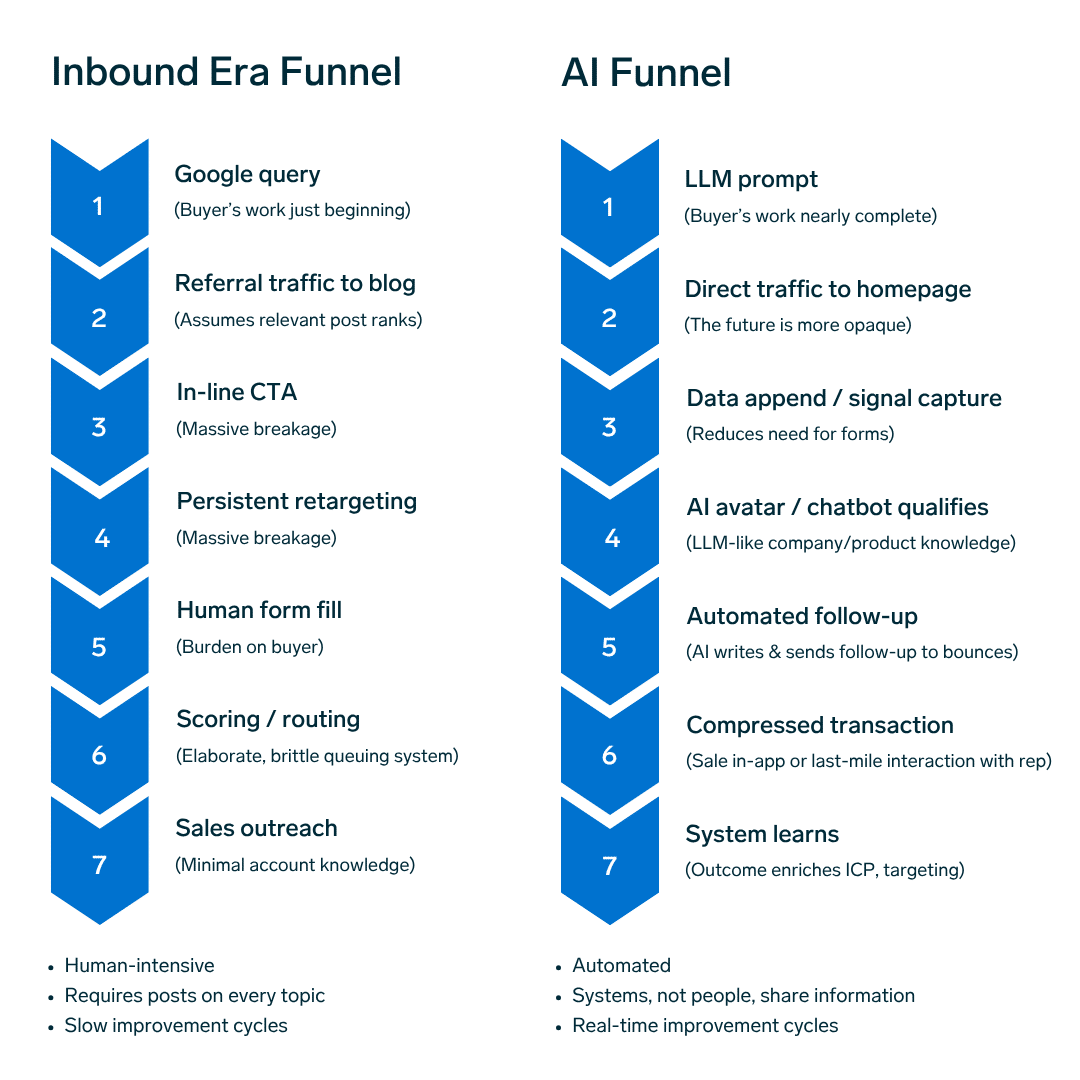I recently gave a marketing talk at Columbia Business School. My deck consisted of a dozen slides for a 30-minute session. We spent 45 minutes on this one.

This slide compares the classic inbound B2B sales funnel to the emerging AI funnel. At first glance, they look similar: Both start with a query, move through a series of tech-enabled operations, and—if all goes well—end in a sale. But the similarity ends there. The difference begins at the very top.
In the inbound era, everything started with a Google search. The buyer’s education began there—and the vendor who captured the lead was the one who ranked for the right keyword and offered an attractive conversion asset.
Now? The buyer starts with a prompt, not a search. The query giveth; the prompt taketh away.
That single shift flips the power dynamic. Where the first click once opened the door for a vendor to educate a buyer, today’s buyer enters the conversation already educated. When knowledge parity replaces information asymmetry, every step that follows must change.
For example, when an LLM has pre-educated your buyer, it’s no longer realistic to expect them to offer up their contact information in exchange for your gated asset (whitepaper etc.). So what to do instead? For starters, strip out all forms; format your website to answer product-specific questions; offer 24×7 sales development coverage through super- intelligent chatbots; automate emails for those who bounce; and, of course, enrich each of these AI-generated interactions with buying-signal insights.
Granted, this new process may break your attribution model, but attribution models were built with the assumption of a form-fill—and LLMs have dramatically reduced the need for a buyer to ever fill out an online form.
Your sales team will also need to reconsider their role in this new era in which the LLM, not the rep, acts as the “trusted advisor.” Naturally, the rep’s initial job is to complete the queued-up transaction. But beyond transacting, I believe the AE’s role will be to sell the roadmap—show the buyer where the product is headed—and foster brand affinity by becoming the buyer’s human connection in a hyper-automated process that until this point may have felt sterile.
It’s not just sales-led motions that need to evolve today. If your company runs a product-led motion, the new race is to get the buyer into the product as fast as possible. Generative code and vibe coding are making feature differentiation less sustainable. So it’s imperative that users experience your product’s value quickly and without friction. Instant value realization becomes the hook.
Ultimately, the era of technology helping humans sell is ending. The era of humans helping technology sell has begun. The next question we’ll all be asking is this: What happens to the funnel when agents—not humans—become the buyers?
The information contained in this market commentary is based solely on the opinion of Joe Chernov, and nothing should be construed as investment advice. This material is provided for informational purposes, and it is not, and may not be relied on in any manner as legal, tax or investment advice or as an offer to sell or a solicitation of an offer to buy an interest in any fund or investment vehicle managed by Battery Ventures or any other Battery entity. The views expressed here are solely those of the author.
The information above may contain projections or other forward-looking statements regarding future events or expectations. Predictions, opinions and other information discussed in this publication are subject to change continually and without notice of any kind and may no longer be true after the date indicated. Battery Ventures assumes no duty to and does not undertake to update forward-looking statements.


A monthly newsletter to share new ideas, insights and introductions to help entrepreneurs grow their businesses.





